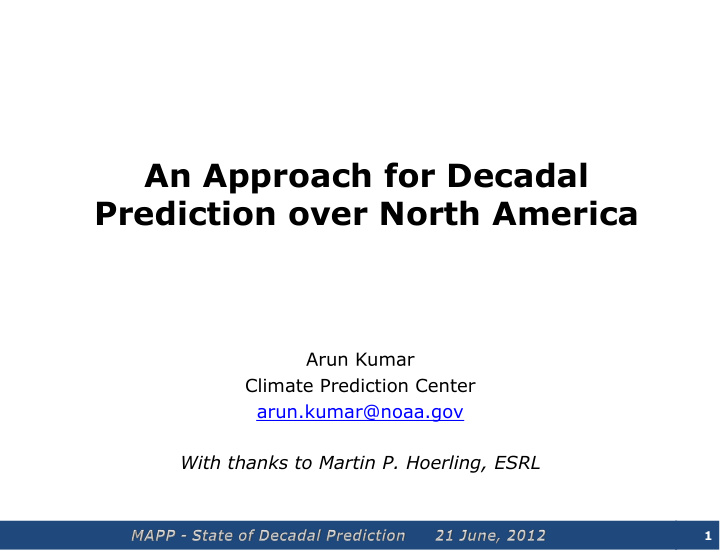



An Approach for Decadal Prediction over North America Arun Kumar Climate Prediction Center arun.kumar@noaa.gov With thanks to Martin P. Hoerling, ESRL 1
Basic Premise of Weather and Climate Predictions For any time-mean (daily, seasonal, decadal…), and • for the variable one is interested in predicting, there is a “climatological (or a reference) Probability Density Function (PDF)”; For specific conditions , the PDF can differ from (or • sub-samples) the climatological PDF. For example, in an initial value prediction problem, a slow growth in perturbations around initial conditions, by sampling the sub-space of the climatological PDF, renders predictability. 2
An Example for Seasonal Predictions • As an example for the prediction of seasonal mean precipitation, difference between the climatological PDF and the PDF for a particular season may occur due to – Atmospheric initial conditions; – Local initial boundary conditions (e.g., soil moisture); – Remote initial boundary conditions (e.g., ENSO SST); – Initial conditions of external forcing (e.g., CO 2 ; volcanic aerosols;…) • Different factors affect the PDF on different time-scales, and with different magnitude 3
Decadal Predictions • For decadal predictions predictability can arise from – Initial conditions in external forcings (e.g., CO 2 ; volcanic aerosols) – Initial conditions in ocean (e.g., AMOC, PDV,…), land , atmosphere • Consider two idealized climate systems – System A: All variations in decadal mean arise from daily weather – No decadal predictability from any initial condition – System B: All variations in decadal means arise from slow decadal modes (e.g., AMOC, PDV) or from slow changes in external forcings (CO 2 ) – When initialized, PDF of the mean for the subsequent decade can be distinguished from the reference PDF, and has higher predictability 4
Key Questions on Decadal Predictability & Predictions • Is the nature more like System A or System B? • What are the slowly evolving “decadal modes” and time-scale of their predictability? • What is the influence of “even slower evolving” external forcing? 5
An Approach for Decadal Prediction over North America Estimating response to GHG forcing for 2011-2020 • Estimate response in SST due to CO 2 Three estimates (one based on CMIP3 – and two based on observational data) Use SST estimates as a forcings in AMIP simulations to generate large – ensemble of decadal means to estimate the “response” to external forcings Estimating magnitude of internal decadal variability • AMIP simulations from 1902-2004: Provide estimates of variability in decadal – means due to Atmospheric internal variability • Response due to different slow “internal modes” of SSTs • Sum of two is the total variability of decadal means (for a fixed external forcing) • CMIP3 preindustrial simulations: Provides an independent estimate for total – variability of decadal means (for a fixed external forcing) 6
Different Estimates of 2011-2010 SST related to external forcings Ribes et al., 2010 Hurrell NOAA CMIP3 7
Decadal Mean Signal ( due to GHG forced SSTs ) 8
Decadal “Signal” and the Decadal “Noise” 9
PDF of Decadal Means - Based on GHG forced SST response - PDF Mean/Median shift denotes magnitude of the decadal signal due to GHG SST effect - PDF spread denotes magnitude of “atmospheric internal variability” (and does not include the component related to the “response” due to “internal modes” of SST variability). 10
Spread in decadal means due to the “internal modes” of SST variability (from AMIP simulation) 11
PDF for Decadal Means 2011-2020 Under the Influence of External Climatological Forcing (and without any specific (reference) PDF knowledge about the slow modes of for Decadal Means SST during this decade; i.e., all modes of SST are equally likely) 12
Summary • Except for precipitation over NA, PDFs are well separated from the climatological PDF (1971-2000 conditions), and the signal-to-noise ratio is large • Weather-driven noise of decadal variability is appreciable, and signifies limitations on decadal predictability • Need to extend similar analysis back in time, and develop verification statistics; • Could also estimate SST trajectory for the next decade and further constrain the PDF. 13
References Hoerling et al., 2011: On North American Decadal Climate for • 2011-2020. J. Climate , 24, 4519-4528. Ribes, A., J.-M. Azais, and S. Planton, 2010: Amethod for regional • climate change detection using smooth temporal patterns. Climate Dyn. , 391–406, doi:10.1007/s00382-009-0670-0. References on SST being the mediator for the terrestrial response to • external forcings: Hoerling, M., T. Xu, G. Bates, A. Kumar, and B. Jha, 2006: Warm oceans raise land – temperatures. Eos, Trans. Amer. Geophys . Union, 87, doi:10.1029/2006EO190003 Hoerling M., A. Kumar, J. Eischeid, and B. Jha, 2008: What is causing the variability in – global mean land temperature. Geophys. Res.Lett., 35, L23712, doi: 10.1029/2008GL035984. Dommenget, D., 2009: The ocean’s role in continental climate variability and change. J. – Climate , 22, 4939–4952. Compo, G. P., and P. D. Sardeshmukh, 2009: Oceanic influences on recent continental – warming. Climate Dyn ., 32, 333–342 doi:10.1007/s00382-008-0448-9. 14
Backup 15
Initialized decadal predictions with short lead PDF for initialized decadal prediction (external forcing + ICs) P ¡ σ ¡ Initialized decadal μ predictions with longer lead X ¡ PDF for a different external forcing (based on long CMIP runs) P ¡ Climatological σ ¡ (reference) PDF μ X ¡ 16
Recommend
More recommend